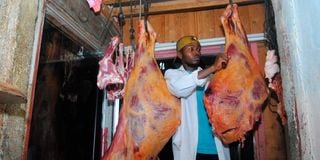Premium
What meat consumers need to know

Charles Rubia at his butchery in Elburgon. Beef, like any other foods of animal origin, has a short keeping time.
Joe, a beef cattle farmer, has walked his three-year-old Sahiwals to the market for sale. This has been his main economic activity for years.
Occasionally, some animals presented to the market fail to get a buyer, resulting in Joe walking them back home, about 10 kilometres away. This is after exposing them to all sorts of infections, fatigue and stress.
Lately, however, Joe has adopted technology and only sells his cows on order directly from his farm.
Additionally, he has instituted a disinfectant foot bath at his gate for traders visiting to purchase his cattle. This has ensured his animals do not contract infections that would compromise the safety of meat.
By not walking his animals for long distances, Joe has improved the quality and ultimately safety of beef from his sahiwals.
Disease preventive measures (biosecurity) go a long way in ensuring the safety of beef products.
Other measures Joe has instituted are proper animal nutrition, which results in enhanced immunity and therefore reduced antibiotic use and residues.
In so doing, his sahiwals will be healthy and consequently provide safe and quality meat.
At the local abattoir where Joe’s sahiwals are slaughtered, the management has adopted hygienic practices as advised by veterinary officers.
Operations are significantly different. Chaotic scenes that characterise abattoirs are history.
There is no more crowding. Only a few flayers and butchers are allowed in and hand-washing and sanitising is the modus operandi.
The informal animal market near the slaughterhouse no longer operates, meaning there is no hawking.
By adhering to strict rules, the butchers and flayers have reduced chances of contaminating the beef and by-products with food-borne agents.
Licensed meat transporters ensure that beef is delivered to retail outlets.
It is important to note that beef, like other foods of animal origin such as milk, mutton, chicken and pork, has a short keeping time.
After training and sensitisation, transporters have resolved to keep to designated working timelines and geographical boundaries. This is helping in delivering fresh food to consumers.
Because of the timelines, what materials can transport meat and how far they can be transported are defined in existing laws. For purposes of safety, compliance should be emphasised.
Simple actions like regular hand-washing have become a norm.
Outlets like butcheries and supermarkets where Joe’s products end up being a lot more conscious of meat-handling hygiene, meaning consumers are protected from food-borne infections.
Other value chains like milk also benefit from hygienic handling at the point of dispensing.
Considering that the safety of meat, milk, mutton and other products is a factor of cumulative controls along the value chain from the farm (producer) to the fork (consumer), it is imperative that hazards be prevented.
The farmer should ensure his animals are healthy by adhering to good practices like vaccination, biosecurity measures, engaging registered health professionals as well as providing proper nutrition.
Movement of animals should only be after certification by government authorities.
Processors and other stakeholders in the value chains should operate within the requisite laws to safeguard the safety of the consumer.
The popular adage, “Health is Wealth”, cannot be over-emphasized.
Nazaria Nyaga is the acting Director of Veterinary Services, Kajiado County




